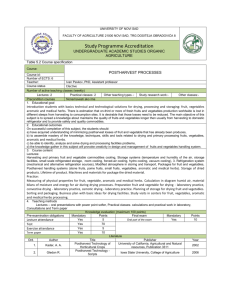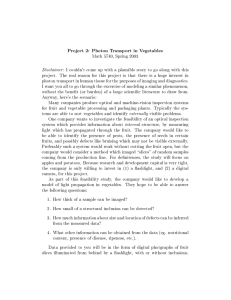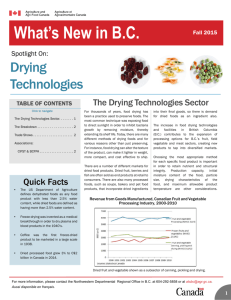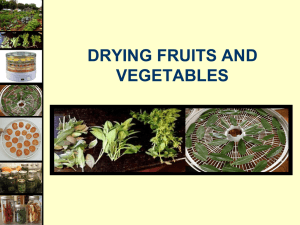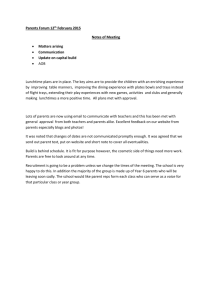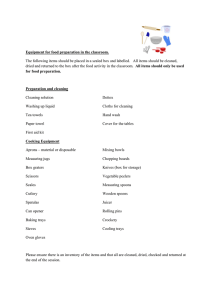nd bIi as Oregon State University Extension Service
advertisement
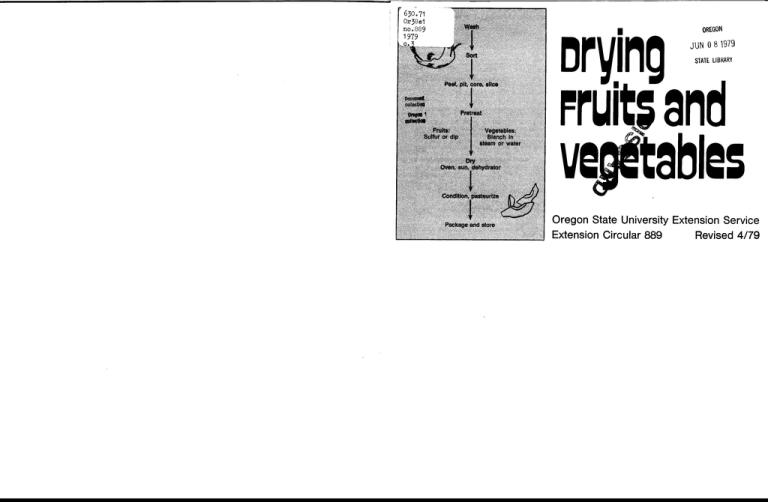
630.71 0r38e1 Wash no.889 1979 I OREGON JUN 08 1979 Sort STATE LIBRARY 'I Peat, pit, core1 slice Dncume4 Pretreat as Oreg i I Fruits: Sulfur or dip Vegetables: Blanch in steam or water Dry Oven sun dehydrator nd bIi Oregon State University Extension Service Revised 4/79 Extension Circular 889 Drying is the oldest method of food preservation. In recent years there has been renewed interest in drying. Many Oregonians are now drying fruits and vegetables at homein the sun, in the oven, and in dehydrators. To decide if drying is the food preservation method you should choose, consider the following points: Prepare the produce immediately after gathering and begin drying at once. Wash or clean all fresh produce thoroughly to remove any dirt or spray. Sort and discard any defective food. Decay, bruises, or mold on any piece may affect an entire batch of food being dried. Use the preparation methods specified on the chart, Steps for Fruits and Vegetables, beginning on page 5. Pretreat fruits and vegetables as directed on the chart to slow down or stop enzyme activity. Enzymes in fruits Drying Skill Drying is a relatively simple process. There are, however, various recommendations for treatment before drying, methods of drying, temperatures and drying times, and conditioning before storage. You may have to use the trial and error" approach in finding out which drying technique works best for your situation. and vegetables are responsible for color and flavor changes during ripening. These changes will continue during drying and storage unless the fruits and vegetables are pretreated. Pretreatment such as antioxidant coating, blanching, or sulfuring may be recommended. Time Food must be watched constantly during the drying process. In addition, time is needed to reconstitute most fruits and vegetables before serving. Storage Space Dried foods require less storage space than canned or frozen foods. Family Preferences The flavor of dried fruits and vegetables will be different from canned or frozen foods. Nutritional Value There is some loss of nutrients during food preser- vation and storage. The loss is usually greater in dried Pretreating Vegetables Most vegetables should be treated before drying. The exceptions include mature peas and beans and some types of corn. Blanching is the recommended pre-treatment for vegetables. The steam-blanching method is preferred over the boiling water method because it retains more of the water-soluble nutrients. Blanching before drying helps save some of the vita- min content, sets the color, hastens drying by relaxing the tissues, helps prevent undesirable changes in flavor during storage, and helps insure satisfactory reconstitution during cooking. 1. Use a deep kettle with a close fitting lid and a fruits and vegetables than in canned or frozen foods. wire basket, colander, or sieve placed so the steam will Equipment While proper equipment is important, it does not have to be expensive: Stainless steel knives to prevent discoloration of food. circulate freely around the vegetables. For blanching vegetablesdeep kettle with close-fitting lid; wire basket, colander, or sieve. For pretreating fruitcontainers to hold solutions; sulfur cabinet (optional). Shallow drying trayswooden frames with slatted or mesh bottoms. Galvanized screen should not be used for tray bottoms. It has been treated with zinc and cadmium which can cause dangerous reactions when in contact with acid foods. Trays for sun-drying can be any size but should be easy to handle when loaded. A suggested tray size is 14"x24"xl". Trays used in an oven or a dehydrator should be at least 1 ½ inches smaller in length and width than the oven or dehydrator to allow air circulation. Dehydrator (optional)see EC 855 "How to Build a Portable Electric Food Dehydrator." Containers for dried foodsjars, cans, plastic containers. Preparing Foods for Drying Foods selected for drying should be of the highest quality possiblefresh and fully ripened. Wilted or inferior produce will not make a satisfactory dried product. Immature produce lacks flavor and color. Over-mature produce may be tough and fibrous or soft and mushy. 2. Layer the vegetables loosely in the basket no more than 21/2 inches deep. 3. Add several inches of water to the kettle and bring to a brisk boil. Place the basket of prepared vegetables in the kettle. Make sure the water does not come in contact with the vegetables. 4. Steam the vegetables until each piece is heated through and is thoroughly wilted. See the chart for recommended times. 5. Test by removing a piece from the center of the vegetable layer and pressing it. It should feel tender but not completely cooked. 6. Remove basket and drain vegetables on paper towels or clean cloths. 8. To provide air for the burning sulfur, leave the Pretreating Fruits bottom of the box slightly propped up, or cut an opening at the bottom about 1 by 6 inches, leaving a flap. The opening should be on the side by the sulfur. A slash or small opening may be needed at the upper edge of the opposite side. Drop the box or close the openings after Various methods, with different degrees of effectiveness, are used to pretreat fruits. Sulfuring Many fruits, especially apples, apricots, peaches, nec- the sulfur has completely burned. tarines, and pears, tend to darken during drying and storage. Sulfuring preserves color and also decreases 9. Count sulfuring time after the sulfur has finished burning. Various factors affect sulfuring time including texture of the fruit, size of pieces, and whether fruit is to be sun-dried or dried under controlted conditions. After sulfuring the recommended length of time, remove the loss of vitamins A and C. The sulfuring minimizes microbial spoilage and insect infestation. For these reasons, it is usually recommended for fruits that are to be sun dried. trays and begin drying the fruit. Outdoorssulfur box Sulfur may be purchased at most pharmacies as flowers of sulfur or sublimed sulfur. These forms usually have a high degree of purity. Garden dusting sulfur is not suitable. 1. Always sulfur outdoors in the open air. Sulfur fumes can be irritating to the eyes and nose. 2. Use wooden trays with ventilated bottoms. Do not use aluminum or galvanized screening materials because sulfur fumes will discolor and corrode most metals. 3. Weigh fruit of the same type and size and spread in a single layer on trays. Place skin side down to help prevent loss of juices. 4. Stack trays at least 11/2 inches apart so sulfur fumes can circulate. Raise the bottom tray with wooden blocks or bricks to at least 4 inches above the ground. Indoorssodium sulfite solution Separate trays with small wooden blocks or spools. 5. Pour sulfur about 1/2 Sodium sulfite, sodium bisulfite or sodium metabisulfite can be used. Do not use bisulfate. These compounds are sometimes available from drug stores, food chemical wholesalers, or stores that sell wine-making supplies. Be sure to purchase U.S.P. (food grade) or Reagent Grade (pure) sulfur material. Practical grade is not pure. inch deep into a clean, metal container that is shallow but deep enough to prevent overflow. For each pound of prepared fruit, use 1 to 2 teaspoons of sulfur if sulfuring time is less than 3 hours; 3 teaspoons of sulfur if the sulfuring time is 3 hours or Prepare a solution of 1 to 2 tablespoons of sodium longer. See the chart beginning on page 6 for specific sulfite in 1 gallon of water. Soak the fruit 10 to 15 minutes. Drain well. Fruit treated in this way will take longer to dry than fruit that is not soaked. times. 6. Place the container of sulfur beside the stacked trays. Ignite the sulfur. Do not leave burned matches in the containers; they may keep the sulfur from burning completely. Because of the flame and the heat from the burning sulfur, allow sufficient spaces between the con- Saline Solution Prepare a solution of 2 to 4 tablespoons of salt in 1 gallon of water. Soak the fruit 10 to 15 minutes. Drain well. Fruit treated in this way will take longer to dry than fruit that is not soaked. tainer and the trays and the sides of the cover. The burn- ing time of sulfur will vary with the ventilation, shape of sulfur container, weather conditions, and amount of food to be sulfured. Ascorbic Acid Solution Pure ascorbic acid (vitamin C) is an antioxidant that helps to keep fruit from darkening as it is being prepared for drying. Make the solution recommended for specific fruits on the chart beginning on page 6. One cup of solution should treat about 5 quarts of cut fruit. Sprinkle the solution over the fruit pieces, turning them gently until all are coated. Pure ascorbic acid usually can be obtained 'Ox =1IIIl WOODEN TOAY from pharmacies. Commercial antioxidant mixtures containing ascorbic S LOCKS acid may be used, but they are not as effective as the pure ascorbic acid. These mixtures, often used in preparing fruits for freezing, usually are available in drug and grocery stores. Follow label directions for use. HICKS DO WOOD ILOCKS OPENING Steam-Blanching Fruits may be steam-blanched if they are to be dried under the controlled conditions of an oven or dehydrator. Blanching gives a darker colored product than other pre- 7. Cover the stacked trays with a heavy cardboard carton or a wooden box that has no cracks or openings. The box should be several inches higher than the stacked trays and at least 1 to 11/2 inches wider around all sides of the trays, including the sulfur container placed beside treatment methods and may give a slightly cooked flavor to some fruits such as apricots, peaches, and pears. Blanched fruits may be soft and somewhat difficult to handle as well. Follow the steam-blanching directions given for vegetables. them. 2 Sun-Drying Syrup-Blanching Syrup-blanching produces a sweetened, "candied" type of fruit. It helps to retain the color of apples, apricots, figs, nectarines, peaches, pears, and plums. Make a syrup using 1 cup corn syrup and 1 cup sugar to 3 cups water or use 1 part corn syrup to 1 part water. Place trays of pretreated fruits or vegetables in the direct sun in a flat or tilted position that allows air to circulate underneath them. Select a drying area that offers some protection from dust, dirt, and animals. To protect against insects, place netting or screening over but not touching the food. Turn the food occasionally to help it dry evenly. An electric fan directed onto the food will hasten the drying and help keep insects away. (For safety, be sure Heat the syrup to boiling. Add the prepared fruit and simmer 10 to 15 minutes. Remove the pan from the heat and let the fruit stand in the syrup for 10 minutes longer. Lift out, drain, and cool. Fruit treated in this way will take longer to dry. the fan has a grill covering the blades.) When the food seems about two-thirds dry, move the trays into the shade and continue drying until "done." Do It should be well protected if dried outdoors because it will attract insects. not allow the sun to scorch or sunburn the food. Cracking Skins of Fruit Fruits such as grapes, prunes and small dark plums, If there is a chance of moisture during the night, bring the trays indoors or stack them, covered, in a sheltered area. Let the food cool somewhat before packaging cherries, figs, and some firm berries like blueberries have it. Oven-Drying Products dried in controlled heat generally will be superior to sun-dried ones in color, flavor, cooking quality, and nutritive value. Oven-dried food is more likely to be free from insects and insect eggs that often appear in food dried outdoors. Controlled-heat drying has the advantage of reducing drying time since it continues after sundown and during rainy as well as sunny weather. There are, however, the additional equipment and operating expenses to consider. 1. When using a home oven for drying, limit the oven load to no more than 4 to 6 pounds of fresh, prepared food at one time. 2. Use trays that are at least 11/2 inches smaller than the width and depth of the oven. Separate trays by about relatively tough skins with a wax-like coating. To allow inside moisture to come to the surface, the skins are often cracked or "checked" to remove this waxy substance. To crack the skins, dip fruit into briskly boiling water, then into very cold water, and thoroughly drain it on ab- sorbent toweling. The length of the boiling water dip varies from 30 to 60 or more seconds. The longer dip is necessary for fruit with tough skins, immature fruit, and fruit checked at high altitude where the boiling temperature is lower than at sea level. Drying Methods Before drying pretreated food, remove any excess moisture by placing the food on paper toweling or clean cloths. Then arrange the prepared vegetable or fruit on the drying trays in a thin layer, usually not over 1/2 inch deep. If needed, spread clean cheesecloth on the trays to prevent food pieces from sticking or falling through. Successful drying depends upon: Enough heat to draw out moisture, but not enough to cook the food 2'/2 3. An oven temperature of 140° F is desirable for drying. Disengage, remove, or do not light the top heating element of the oven. Preheat the oven at its lowest setting. Prop open the door to maintain the low temperature and to let moisture escape during drying. The opening will vary among ovens from a 1/2-inch to 8-inch crack. 4. Allow the oven to cool down to 140° F. Use a thermometer to check the temperature throughout the Dry air to absorb the released moisture Air circulation to carry the moisture off drying process. If using other than an oven thermometer, be sure the bulb does not touch any surface. Moisture must be removed from the food as fast as possible at a temperature that does not seriously affect the flavor, texture, and color of the food. If the temperature is too low in the beginning, the food may undergo undesirable microbiological changes before it dries ade- 5. Place the trays in the oven. Turn the food occasionally. Shift trays from shelf to shelf every half hour or so and turn trays front to back. It is helpful to number the trays and keep a record of the shifts. 6. If some pieces around the tray edges dry first, remove them first. It is easy to scorch food that overheats near the end of the drying time. To avoid this, turn off the heat when drying is almost completed and open the oven door wide. the temperature is much too high and the humidity too low, the food may harden on the surface. This makes it more difficult for the moisture to escape quately. inches. Allow at least a 3-inch clearance from the top and the bottom of the oven. If for the food to dry properly. 3 To 'pasteurize, use whichever of the following methods is suitable: Dehydrator Drying Dehydrators can be made fairly easily at various costs. Heat fruits and vegetables on trays in a 150° F. oven for 30 minutes. Prepare foods and load trays as for oven-drying. Maintain the temperature at 135° to 140° F. Rotate and check trays occasionally. Heat the food on trays in a 175° F. oven: Fruits-15 minutes; vegetables-10 minutes. Testing for Dryness Foods should be dry enough to prevent microbial Packaging and Storing growth and subsequent spoilage. Dried fruits should be leathery and pliable. Dried vegetables should be hard and brittle. Most vegetables take 4 to 12 hours to dry in the oven; fruits take 6 to 20 hours. Time varies according to the kind of fruit or vegetable being dried, the size of pieces, Dried foods should be thoroughly cooled before packaging. Pack the food as tightly as possible without crushing into clean, dry, insect-proof containers. Metal cans or boxes with fitted lids, glass jars, or moisture-vapor proof freezer cartons or bags (heavy gauge, plastic type) make good containers for storing dried foods. Separate sulfured fruit from a metal can or lid by putting the fruit into a plastic bag or inserting a cellophane or polyethelene sheet under the lid. Color changes take place when sulfur fumes react with metal. To insure protection from insects and to prevent any reabsorption of moisture, seal lid.s to the containers. Wrap the rim edge with a plasticized pressure-sensitive tape or with a clean 1 inch strip of tloth that is still warm after having been dipped in paraffin. Herbs dried on the stem may be stored on the stem in plastic or paper sacks to protect them from the dust if and the load on the trays. Dehydrator-drying generally takes less time than oven-drying, Sun-drying takes considerably more time. Before testing foods for desired dryness, remove a handful to cool for a few moments. Foods that are warm or hot seem more soft, moist, and pliable than they actually are. Check the chart beginning on page 5 for specific drying tests for fruits and vegetables. ample storage space is available. Otherwise, store the dried leaves, whole or crushed, in an appropriate con- -Z__. -- r-7 tainer. Package in small amounts because dried foods are best if used within a short time after the container has been opened. 0 Conditioning and Pasteurizing Most fruits should be allowed to sweat" or condition for a week after drying. This equalizes the moisture. Apricots, in particular, develop a candy-like consistency during conditioning. To condition, place fruit in a sturdy, nonporous, nonaluminum container and put in a warm, dry, well-ventilated and protected area. Stir the food gently each day. Certain dried foods need to be pasteurized (heated briefly) before storage to prevent spoilage: Sun-dried foodsInsects may be found on foods dried outdoors. Vegetables cut in small piecesThe short drying time may not have destroyed organisms that can cause spoilage. Foods allowed to stand exposed to air, such as during conditioningIn moist climates it is advisable to pas- teurize foods after conditioning to remove moisture that has been reabsorbed. Most dried foods should be stored in a cool, dry, dark place. Recommended storage times for dried fruits and vegetables range from six month.s to one year. Because food quality is affected by heat, the storage temperature helps determine the length of storage: the higher the temperature, the shorter the storage time. Labeling the packaged foods with the date of packaging and the name of the product is helpful. Food that is packaged seemingly "bone dry" can spoil if moisture is reabsorbed during storage. Check from time to time to see that it has remained dry. Glass containers are good for storage because any moisture that collects on the inside can be seen easily. Food affected by moisture, but not spoiled, should be used im- mediately or reheated and repackaged. Moldy food should be discarded. Preparing for Table Use Reconstituting Vegetables One cup of vegetables reconstitutes to about 2 cups. To replace the moisture removed from most vegetables, soak them in cold water just to cover for 20 minutes to 2 Properly dried foods reconstitute well. They return to approximately their original size, form, and appearance. If carefully handled, they retain much of their aroma and hours. Cover greens with boiling water. flavor. To cook, bring vegetables to a boil and simmer until done. Allow excess water to evaporate during cooking or use stock for part of the water needed in recipes. Like fresh foods, dried ones will lose both texture and flavor if overcooked. Dried vegetables already have been Reconstituting Fruits One cup of dried fruit reconstitutes to about 11/2 cups. Add water just to cover the fruit; more can be added later if needed. One to eight hours are required to reconstitute most fruits. The time varies with the kind of fruit, the size of the pieces, and the temperature of the water (hot water takes less time). Oversoaking will pro- partially precooked and therefore can be prepared for the table in a short time. Using in Recipes Dried fruits and vegetables can be used in a variety duce a loss of flavor. Drying does not render the food free from bacteria, yeasts, and molds; therefore, spoilage will occur if soaking is continued too long at room temperature. Refriger- of ways. Dried fruitsUse for snacks at home, on the trail, or on the ski slopes. Use pieces of dried fruit in cookies. ate fruit if soaking for longer than 1 hour. Reconstituted To cook reconstituted fruit, cover and simmer in the fruitsServe as a compote or as a sauce. The reconstituted fruit can also be incorporated into favorite recipes for breads, gelatin salads, omelets, stuffing, milkshakes, homemade ice cream, and cooked cereals. Any liquid remaining after soaking can be used soak water to retain the nutritive quality. Sometimes less sugar is needed in cooking dried fruit than in cooking fresh fruit. During the drying process, some of the starch in fruit may change to sugar. When sugar is used, it should be added at the end of the cooking process so it will not interfere with the fruit's absorp- as part of the water needed in the recipe. Dried vegetablesAdd to soups and stews. Reconstituted vegetab/esInclude in favorite recipes for meat pies and other main dishes as well as gelatin tion of water. Adding a few grains of salt helps bring out the natural sweetness of most fruits. Lemon, orange, or grapefruit juice added to the fruit just before serving will help give a fresh fruit flavor and add vitamin C to the food. and vegetable salads. Dried Use 1/3 herbsSubstitute for fresh herbs in recipes. to 1/2 teaspoon of dried herbs to equal 1 table- spoon of fresh herbs. Steps for Drying Vegetables Refer to text for details. Increase blanching time for large quantities or at high altitudes. VEGETABLE Beans, lima PREPARATION Shell. PRETREATMENT Choose one: DRYING PROCEDURE Spread on tray about Steam 10 to 15 minutes. Place in boiling water 5 deep. minutes. Drain. ning. Y2" Stir frequently at beginDrying time averages 6 to 10 hours in controlled heat. Dry until hard and brittle. Beans will break clean when broken. Carrots Select crisp, tender car- Steam-blanch 8 to 10 mm- Arrange in a thin layer on rots, free from woodiness. utes. trays. Wash. Dry until tough and leath- Trim off the roots and tops. ery. Cut into slices or strips about Corn Any good table variety. '/8" thick. Select tender, sweet corn. Husk. Sort ears on basis of maturity. Young corn requires longer blanching time. Cut from cob after blanching and cooling enough to Steam on the cob 10 to 15 minutes or until milk is set. Scrub thoroughly. Peel large mushrooms. Slice caps. Cut tender stalks into short sections. 3/4 Stir frequently to prevent kernels from lumping. Drying time averages 6 to 10 hours heat. in controlled Dry until hard and brittle. handle. Mushrooms Caution: Only an expert can identify edible varieties Spread kernels '/2" to deep on trays. No treatment necessary. Spread in a thin layer on trays. Drying time averages 3 to 5 hours in controlled heat. PREPARATION FRUIT Onions Select pungent varieties. Peel. PRETREATMENT DRYING PROCEDURE No treatment necessary Spread thinly on trays. In controlled heat, dry 6 to 10 hours at 140° F. Dry until brittle and light Remove outer discolored layers. Cut uniform slices 1/4F 1/8/ to colored. thick. For onion powder, crush slices after drying. Peas Select young, tender peas of a sweet variety. Shell. Choose one: Steam-blanch 8 to 10 min- Spread thinly on trays. Drying time averages 6 to utes. 10 Dip in boiling water 3 to 4 heat. hours in controlled Dry until hard and shriv- minutes. eled. Peas should shatter when hit with a hammer. Peppers, green chili To loosen skin, rotate pepper over flame or scald in boiling water. Peel, Spread in a thin layer on Choose one: No treatment necessary. trays. Steam-blanch 10 minutes. Dry until crisp and brittle. No treatment necessary Drying time in controlled split pods, and re- move seeds and stem. Peppers, red chili Select mature pods. heat, 6 to 10 hours at 150° in room temperature, several weeks. Dry until pods are shrunken, dark red, flexible. Wipe clean with damp cloth. String whole pods to- F.; gether with needle and cord or hang bunches, root side up, in airy place. Squash, summer Crookneck Scallop Zucchini Tomatoes, for stewing Spread in a thin layer on . Steam-blanch 6 minutes. Wash. Trim. trays. Cut into Dry until brittle. Y4" slices. Steam or dip in boiling water to loosen skin and Steam-blanch 3 minutes. Drying time averages 4 to 8 hours in controlled heat. chill. Peel. Cut large tomatoes Spread in single layer on trays. into sections or slice. Cut small tomatoes in half. 3/4 Steps for Drying Fruits Refer to text for details. Apples Use varieties of good dessert or cooking quality. Mature but not soft. Wash, peel, and core. Cut into slices or rings 1/8 to 1/4P thick, or into quarters shape during drying. utes. deep. of Drying time approximately 6 hours in controlled heat. Soak 10 to 15 minutes in sodium sulfite solution or Dry until leathery and suede-like. There should moisture when be no Coat with ascorbic acid depending pieces. to prevent darkening. Wash, cut in half, and pit. Do not peel. Coat with ascorbic acid solution (1 tsp. pure crystalline ascorbic acid in each cup of cold water) to prevent darkening. trays not more than two layers Sulfur 30 to 60 minutes to each cup cold water) on Blanch in steam 10 mm- or eighths. solution (21/2 tsps. of pure crystalline ascorbic acid Apricots Use any variety. Fully ripened but not so soft they are easily mashed or lose Arrange slices Choose one: on size saline solution. Choose one: Sulfur 1 to 2 hours de- pending on size of pieces and ripeness of fruit. Riper fruit absorbs sulfur more slowly. Steam-blanch halves 5 to 10 minutes. Blanch in a hot syrup made of equal parts corn syrup and water or sugar and water. Soak 10 to 15 minutes in sodium sulfite solution or saline solution. cut slices are squeezed. Arrange in single layer on drying trays, pit side up. Average drying time for halves up to 14 hours in controlled heat; 1 to 2 days in the sun. Dry until leathery and suede-like. There should moisture when be no cut slices are squeezed. FRUIT PREPARATION cerrues Sort, wash, whole. Firm type. and leave PRETREATMENT Choose one: DRYING PROCEDURF No treatment necessary. Steam 1/2 to 1 minute. Crack tougher skins by dipping 15 to 30 seconds boiling water, then in cold water. Remove exin cess moisture. Spread in layer not more than 2 berries deep. Cloth on tray may help keep berries from sticking. Drying time up to 4 hours in controlled heat. Dry until berries are hard and rattle when shaken on the tray. There should be no moisture when berries are crushed between the fingers. Cherries Sort, wash, leave whole or stem and remove pit. Choose one: No further treatment necessary. Check skins of whole cher- ries in boiling water 15 to 30 seconds, cool immediately, and remove mois- Dry in trays. single layers on Drying time up to 6 hours. Dry until leathery slightly sticky. and ture. Syrup-blanch. Figs Select fullyripefruit. When not fully ripe, the sugar content is too low to pro- duce a good dried product and fruit may sour. Wash, or clean whole fruit with damp terry cloth. If small or partly dried on tree, leave whole. Otherwise, cut in half lengthwise. Choose one: Check skins of whole figs by dipping in boiling water for 30 to 45 seconds. Cool quickly, and remove excess moisture. Sulfur light colored varieties (like Kadotas) for 1 hour or more. Sulfuring is optional with o t h e r s. (Black figs will turn a mottled color when sulfured.) Spread in single layers on trays. Stir or turn figs to keep from sticking. Drying time averages up to 5 hours for halves in controlled heat; about 3 days in the sun. Dry until leathery, with flesh pliable yet slightly sticky. cut, steam-blanch 20 minutes. If Syrup blanch. Grapes Any seedless varieties. Nectarines Wash, and remove all defective fruit. Leave whole on stem; cut closely packed stems into small bunches; or remove from stems. Choose one: Peel if desired. Halve and stone, Choose one: Steam-blanch halves 15 to 18 minutes, slices 5 minutes. Sulfur slices 1 hour, halves or quarters 2 hours. If blanched, sulfur 30 and 90 minutes, respectively. Cut into quarters or slices. To prevent browning during preparation, treat with ascorbic acid solution as for apricots. No treatment necessary. Dip in boiling water 15 to 30 seconds to crack Spread in a single layer. Drying time averages up to 8 hours in controlled heat. skins; then in cold water Dry until pliable and leath- to cool immediately. Drain. ery. Dry like peaches. Soak 10 to 15 minutes in sodium sulfite solution or saline solution. Peaches freestones enough for fully ripe. Choose one: Steam-blanch Peel. Any good table variety; preferred. Ripe eating but not Cut in half and pit. Arrange in halves 15 Leave in halves or cut in to 20 minutes, slices 5 to quarters or slices. 7 minutes. Sulfur 1 to 2 hours, depending upon size of pieces. If steam-blanched To prevent browning during preparation, treat with ascorbic acid solution as before sulfuring, cut sulfuring time about half. 'Soak 10 to 15 minutes in sodium sulfite solution or for apricots. saline solution. 7 single layers on trays, pit side up to retain juices. 'Turn over halves when visible juice disappears. Drying time under controlled conditions aver- ages up to 15 hours for halves and about 6 hours for slices. Dry until leathery somewhat pliable. and FRUIT PREPARATION Bartlett is best for drying Cut in half lengthwise and Pears PRETREATMENT Pare. core. Cut in quarters or eighths or slices 1/8 to 1/4 thick. To prevent browning during preparation, treat with ascorbic acid as for apricots. DRYING PROCEDURE Choose one: Steam-blanch 5 to 20 minutes, depending upon size of pieces. Spread in single layers on trays. Drying trolled time under conconditions aver- Sulfur as for peaches. ages up to 15 hours for Syrup-blanch. Soak 10 to 15 minutes in sodium sulfite solution or halves or slices. Dry until saline solution. suede-like. There should 6 for hours springy and no moisture when pieces are cut and squeezed. be Prunes Plums Dry whole if small. Otherwise, cut into halves (pit removed) or slices. Choose one: Dip whole fruit in boiling Spread on trays in a single layer. water 30 or more seconds Drying to check skins. Cool and trolled drain. Steam-blanch ages 6 to 8 hours for slices and halves; up to 14 hours for whole fruit. halves 15 minutes, slices 5 minutes. Sulfur whole fruit 2 hours, halves and slices 1 hour. time under conconditions aver- Dry until pliable and leath- ery. A handful of pieces will spring squeezing. apart after Prepared by Carolyn Raab, Extension food and nutrition specialist, Oregon State University Extension Service. OREGON STATE UNIVERSITY EXTENSION ISERVICE Extension Service, Oregon State University, Corvallis, Henry A. Wadsworth, director. This publication was produced end distributed in furtherance of the ACts of Congress of May 8 and June 30, 1914. Extension work I.a cooperative program of Oregon State Univereity, the U. S. Department of AgriCuiture, end Oregon counties. Extension invites participation in its programs and otters them eQually to all pople, without discrimination.
